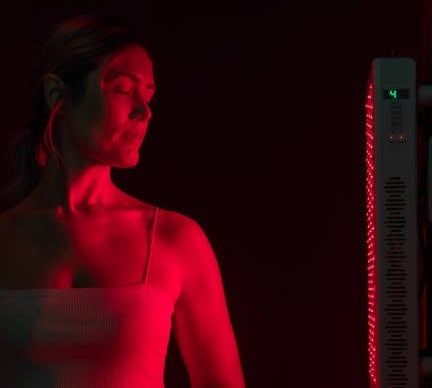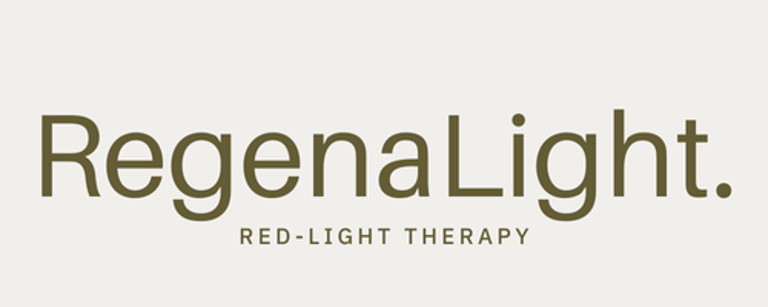Backed by Science.
Photobiomodulation (PBM aka. red & near-infrared light) uses safe, non-ionising wavelengths that your cells’ mitochondria absorb. Research shows these wavelengths can modulate ATP energy production and signalling linked to inflammation, circulation and tissue repair. In practice, sessions may support post-exercise recovery, joint and muscle comfort, and healthier-looking skin. Effects are dose-dependent and build over time.


Benefits
INCREASED CIRCULATION
Supports micro-circulation so oxygen and nutrients reach tissues more efficiently; many people finish feeling relaxed and re-energised.
PAIN MANAGEMENT & INFLAMMATION
May help to calm inflammatory pathways and ease everyday joint and muscle discomfort by supporting the body’s natural repair processes.
IMMUNE SYSTEM & WELLBEING
Supports cellular resilience and a balanced inflammatory response, helping your body’s natural defences and overall vitality.
PERFORMANCE & RECOVERY
Supports cellular energy (ATP) for muscular performance and endurance, and may help reduce post-exercise soreness and recovery times.
SKIN HEALTH & COLLAGEN
Encourages collagen and elastin activity for smoother, firmer-looking skin and improved tone.
SLEEP & RELAXATION
Helps settle the nervous system and support a steadier sleep–wake rhythm; many people report deeper relaxation and more restful sleep.
Wellness service, not a medical treatment. Individual results may vary. For more information about the science behind red light therapy, please see the research summary below.
A Deeper Dive into the Scientific Evidence behind Red-Light Therapy
Red light therapy at 630 nm and 660 nm, and near-infrared (NIR) light at 810 nm, 830 nm, and 850 nm, have demonstrated several benefits in the context of musculoskeletal injury recovery, skin aging and collagen production, and anti-inflammatory effects.
Musculoskeletal injury and wound healing: Both red (630–660 nm) and NIR (810–850 nm) wavelengths enhance wound healing by promoting fibroblast proliferation, collagen synthesis, and angiogenesis, while reducing inflammation. Specifically, 630 nm red light upregulates COL1A1, COL2A1, and VEGF, and reduces IL-1β, supporting tissue regeneration and anti-inflammatory effects.[1] NIR at 810 nm and 850 nm is particularly effective in accelerating wound closure, enhancing collagen accumulation, and promoting re-epithelialization, likely via mitochondrial cytochrome c oxidase activation.[2-5]
Skin aging and collagen production: Red and NIR light (notably 630, 640, 660, 830, and 850 nm) increase the expression of collagen and elastin genes and proteins in human dermal fibroblasts and skin explants, supporting anti-aging and photorejuvenation effects. 660 nm red light produces a durable increase in ATP and procollagen synthesis, while 850 nm NIR stimulates metabolic activity and procollagen I production, especially under physiologic oxygen conditions.[5-8] These effects are associated with improved skin texture and reduced photoaging.
Anti-inflammatory and systemic effects: Red and NIR light (630–850 nm) generally exert anti-inflammatory effects by modulating cytokine production and reducing oxidative stress, which may contribute to improved recovery from injury and reduced chronic inflammation.[1][9-10]
Mood and other potential benefits: While the literature provided does not directly address mood, NIR wavelengths (particularly 810 nm) have been explored for neural stimulation and neuromodulation, suggesting possible benefits in neuroregeneration and cognitive function, though robust clinical evidence is limited.[11]
In summary, red and NIR light at 630, 660, 810, 830, and 850 nm support wound healing, collagen production, and anti-inflammatory effects, with the most robust evidence for skin and musculoskeletal recovery. Effects are wavelength- and cell-type dependent, and optimal dosing parameters remain an area of ongoing research.[1-10][12]
Frequently asked questions
How long are sessions?
Sessions are 20 minutes full-body. You can also book a Double Session (40 minutes back-to-back) if you’d like a deeper dose in one visit.
Does red-light therapy hurt?
No—most people feel gentle warmth and bright light. RLT is generally well-tolerated; the most common side effect reported in dermatology is temporary erythema (redness).
How should I prepare?
Arrive with clean skin and remove sunscreen, makeup, oils or heavy skincare that could block light absorption. Hydrate well beforehand — well-hydrated cells absorb light and produce energy more efficiently. Bring a water bottle for after your session.
What are the potential benefits of RLT?
RLT may help with post-exercise recovery, everyday joint/muscle comfort, healthier-looking skin (collagen support), and circulation—with results accumulating over multiple sessions. Evidence strength varies by goal and protocol.
What is red-light therapy? (PBM)
Photobiomodulation (PBM) uses safe, non-ionising red and near-infrared light that your cells’ mitochondria can absorb. This can modulate cellular energy (ATP) and signalling linked to inflammation, circulation and repair. Effects are dose-dependent and build with consistent sessions.
Does red-light therapy get hot?
You’ll feel mild warmth from the LEDs, but it’s not a sauna and there’s no UV or tanning involved.
What device do you use?
We use the BlockBlueLight Ultimate XXL full-body panel (multi-wavelength 630/660/810/830/850 nm) with 1200 dual-chip LEDs, engineered for low-EMF and flicker-free output. The manufacturer lists irradiance up to ~189 mW/cm² (actual intensity varies by distance and method). The device is described as “FDA registered” by the manufacturer; note that FDA “registration” is not the same as “FDA-cleared/approved.”
What areas of the body are covered?
It’s a full-body session. Most clients do ~10 minutes front + ~10 minutes back at a comfortable standing or seated distance from the panel. Want to target a concern (e.g., knees, shoulders, face)? We can allocate more time to that area within your 20 minutes.
Is there anyone who shouldn’t do RLT?
Please check with your health professional first if you are pregnant, photosensitive, take photosensitising medicines (e.g., certain antibiotics/retinoids), have active cancer, epilepsy/light-triggered conditions, or serious medical concerns. RLT is a wellness service, not a medical treatment.
How often should I do red-light therapy?
Benefits are cumulative. Research and clinical guidance highlight a therapeutic window (too little does little; too much can blunt effects), often called a biphasic dose response. Practically: aim for weekly as a baseline (we’re open Sundays), and consider an occasional Double Session if you want an intensified visit.
What do I wear?
Wear minimal clothing so more skin is exposed (e.g., shorts/sports bra or swimwear). Remove reflective jewellery. We provide eye protection—please use it and avoid staring directly at the LEDs.
RegenaLight.
Red Light Therapy is a wellness service, not a medical treatment. Individual results may vary. For more information about the science behind red light therapy, please see the research summary for more information.
Contact
GET in touch
12 Keate Place, Mount Wellington, Auckland
Email:
regenalightnz@gmail.com
© 2025. All rights reserved.
